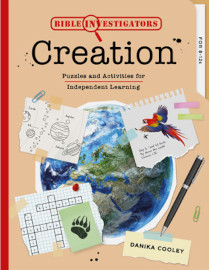Bible Investigators: Creation – Puzzles and Activities for Independent Learning is the most innovative Bible course for ages eight to twelve I’ve seen in years. The lessons draw children into Bible study using all sorts of puzzles, drawing and writing activities, Bible reading, analysis of Bible passages, discussion, and personal application.
While the puzzles are likely to first catch the attention of students, the course offers an in-depth investigation of foundational truths in scripture. The lessons are divided into six sections, titled to indicate the themes covered:
- God Created Everything in the Beginning
- The Story of Creation
- God Made Me
- Our Creator God
- God’s Good Creation Gifts
- God’s Great Salvation Plan
Within each section, several chapters roam through the Bible, expanding each theme. For instance, in section 3, God Made Me, the ten pages of Chapter 14 have students explore Acts 17:24-28, which reads:
24 “The God who made the world and everything in it is the Lord of heaven and earth and does not live in temples built by human hands. 25 And he is not served by human hands, as if he needed anything. Rather, he himself gives everyone life and breath and everything else. 26 From one man he made all the nations, that they should inhabit the whole earth; and he marked out their appointed times in history and the boundaries of their lands. 27 God did this so that they would seek him and perhaps reach out for him and find him, though he is not far from any one of us. 28 ‘For in him we live and move and have our being.’[b] As some of your own poets have said, ‘We are his offspring’ (English Standard Version of the Bible).
Based on these verses, students explore concepts such as God as creator, God giving life to all people, God being self-sufficient, the purpose of our existence, and God’s desire for a relationship with us.
The 30 chapters in the book each cover a range of topics, like those for Chapter 14 and do so in a manner sophisticated enough for seventh graders. So, the concepts, as well as some puzzles, might occasionally be a little beyond third- or fourth-graders. Parents should be working directly with younger students, adapting as needed.
Learning Through Puzzles
The lessons are loaded with several types of puzzles: crossword, word search, maze, code, word scramble, rebus, logic grid, cryptogram, picture sudoku, dot-to-dot, and word ladder. Some “puzzles” have students fill in blanks from scripture verses, based on the English Standard Version of the Bible. Students need access to that version for these and other puzzles. You can access it free online at BibleGateway.com if you don’t have it.
The puzzles both teach and reinforce what students are learning and are essential parts of the lessons rather than add-ons. Younger students might struggle with some of the puzzles and need more assistance.
Throughout the course, students are taken through an “observe, interpret, and apply” process for a verse or passage of scripture, writing their responses for each step. Sometimes, the apply step involves writing a prayer, performing an action, or talking to someone. The overall result is a course that both teaches and moves students to action.
Each chapter might be completed in a week or less, so the entire course can be spread over one or two semesters. An answer key at the back of the book and downloadable from the publisher’s website supplies answers for the puzzles but not the subjective questions.
Students can read and work independently, but the book might also be used as a family study. Free downloadable puzzle pages make it possible to use one book for the entire family, but the printable pages do not include the blocks for drawing and writing that are in the book. Students can write and draw in separate notebooks, but the value of having their own books with all the content, including the instructional text, weighs in favor of the latter. Another reason to buy printed books is the large number of pages to print—more than half the book.
Summary
Bible Investigators: Creation should work well for homeschoolers, whether students work independently or the family studies together. And students will probably love the puzzle approach to learning.










